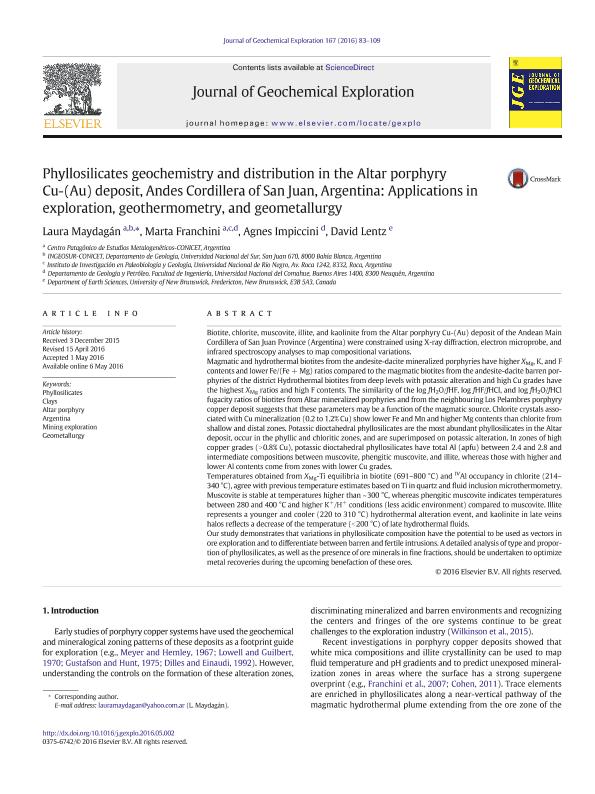Artículo
Phyllosilicates geochemistry and distribution in the Altar porphyry Cu-(Au) deposit, Andes Cordillera of San Juan, Argentina: Applications in exploration, geothermometry, and geometallurgy
Fecha de publicación:
08/2016
Editorial:
Elsevier Science
Revista:
Journal of Geochemical Exploration
ISSN:
0375-6742
Idioma:
Inglés
Tipo de recurso:
Artículo publicado
Clasificación temática:
Resumen
Biotite, chlorite, muscovite, illite, and kaolinite from the Altar porphyry Cu-(Au) deposit of the Andean Main Cordillera of San Juan Province (Argentina) were constrained using X-ray diffraction, electron microprobe, and infrared spectroscopy analyses to map compositional variations. Magmatic and hydrothermal biotites from the andesite-dacite mineralized porphyries have higher XMg, K, and F contents and lower Fe/(Fe+Mg) ratios compared to the magmatic biotites from the andesite-dacite barren porphyries of the district Hydrothermal biotites from deep levels with potassic alteration and high Cu grades have the highest XMg ratios and high F contents. The similarity of the log fH2O/fHF, log fHF/fHCl, and log fH2O/fHCl fugacity ratios of biotites from Altar mineralized porphyries and from the neighbouring Los Pelambres porphyry copper deposit suggests that these parameters may be a function of the magmatic source. Chlorite crystals associated with Cu mineralization (0.2 to 1.2% Cu) show lower Fe andMn and higherMg contents than chlorite from shallow and distal zones. Potassic dioctahedral phyllosilicates are the most abundant phyllosilicates in the Altardeposit, occur in the phyllic and chloritic zones, and are superimposed on potassic alteration. In zones of high copper grades (N0.8% Cu), potassic dioctahedral phyllosilicates have total Al (apfu) between 2.4 and 2.8 andintermediate compositions between muscovite, phengitic muscovite, and illite, whereas those with higher and lower Al contents come from zones with lower Cu grades. Temperatures obtained from XMg-Ti equilibria in biotite (691?800 °C) and IVAl occupancy in chlorite (214? 340 °C), agreewith previous temperature estimates based on Ti in quartz and fluid inclusion microthermometry.Muscovite is stable at temperatures higher than ~300 °C, whereas phengitic muscovite indicates temperatures between 280 and 400 °C and higher K+/H+ conditions (less acidic environment) compared to muscovite. Illite represents a younger and cooler (220 to 310 °C) hydrothermal alteration event, and kaolinite in late veins halos reflects a decrease of the temperature (b200 °C) of late hydrothermal fluids. Our study demonstrates that variations in phyllosilicate composition have the potential to be used as vectors in ore exploration and to differentiate between barren and fertile intrusions. A detailed analysis of type and proportion of phyllosilicates, as well as the presence of ore minerals in fine fractions, should be undertaken to optimize metal recoveries during the upcoming benefaction of these ores.
Palabras clave:
PHYLLOSILICATES
,
CLAYS
,
ALTAR PORPHYRY
,
ARGENTINA
Archivos asociados
Licencia
Identificadores
Colecciones
Articulos(CCT - PATAGONIA NORTE)
Articulos de CTRO.CIENTIFICO TECNOL.CONICET - PATAGONIA NORTE
Articulos de CTRO.CIENTIFICO TECNOL.CONICET - PATAGONIA NORTE
Articulos(INGEOSUR)
Articulos de INST.GEOLOGICO DEL SUR
Articulos de INST.GEOLOGICO DEL SUR
Citación
Maydagán, Laura; Franchini, Marta Beatriz; Impiccini, Agnes; Lentz, David; Phyllosilicates geochemistry and distribution in the Altar porphyry Cu-(Au) deposit, Andes Cordillera of San Juan, Argentina: Applications in exploration, geothermometry, and geometallurgy; Elsevier Science; Journal of Geochemical Exploration; 167; 8-2016; 83-109
Compartir
Altmétricas




